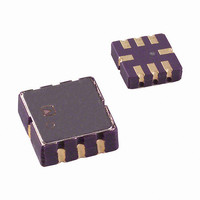ADXL213AE Analog Devices Inc, ADXL213AE Datasheet - Page 9

ADXL213AE
Manufacturer Part Number
ADXL213AE
Description
IC ACCELER DUAL AXIS DGTL 8-CLCC
Manufacturer
Analog Devices Inc
Datasheet
1.ADXL213EB.pdf
(12 pages)
Specifications of ADXL213AE
Acceleration Range
±1.2g
Axis
X, Y
Sensitivity
30°/g
Voltage - Supply
3 V ~ 6 V
Output Type
Digital
Bandwidth
1Hz ~ 500Hz Selectable
Mounting Type
Surface Mount
Package / Case
8-CLCC
No. Of Axes
2
Sensor Case Style
LCC
No. Of Pins
8
Supply Voltage Range
3V To 6V
Operating Temperature Range
-40°C To +85°C
Msl
MSL 1 - Unlimited
Lead Free Status / RoHS Status
Lead free / RoHS Compliant
For Use With
ADXL213EB - BOARD EVALUATION FOR ADXL213
Interface
-
Lead Free Status / RoHS Status
Lead free / RoHS Compliant, Lead free / RoHS Compliant
Available stocks
Company
Part Number
Manufacturer
Quantity
Price
Company:
Part Number:
ADXL213AE
Manufacturer:
ABOV
Quantity:
473
Part Number:
ADXL213AE
Manufacturer:
ADI/亚德诺
Quantity:
20 000
Company:
Part Number:
ADXL213AE-REEL
Manufacturer:
ALTERA
Quantity:
101
APPLICATIONS
POWER SUPPLY DECOUPLING
For most applications, a single 0.1 μF capacitor, C
decouples the accelerometer from noise on the power supply.
However, in some cases, particularly where noise is present at
the 140 kHz internal clock frequency (or any harmonic
thereof), noise on the supply may cause interference on the
ADXL213’s output. If additional decoupling is needed, a 100 Ω
(or smaller) resistor or ferrite beads may be inserted in the
supply line of the ADXL213. Additionally, a larger bulk bypass
capacitor (in the range of 1 μF to 22 μF) may be added in
parallel to C
SETTING THE BANDWIDTH USING C
The ADXL213 has provisions for bandlimiting the X
Y
low-pass filtering for antialiasing and noise reduction. The
equation for the –3 dB bandwidth is
or more simply,
The tolerance of the internal resistor (R
much as ±25% of its nominal value (32 kΩ); thus, the band-
width varies accordingly. A minimum capacitance of 2000 pF
for C
Table 4. Filter Capacitor Selection, C
Bandwidth (Hz)
1
10
50
100
200
500
SELF TEST
The ST pin controls the self-test feature. When this pin is set to
V
meter. The resulting movement of the beam allows the user to
test if the accelerometer is functional. The typical change in
output is 750 mg (corresponding to 23%). This pin may be left
open circuit, or may be connected to common in normal use.
The ST pin should never be exposed to voltages greater than
V
cannot be guaranteed (i.e., multiple supply voltages present), a
low V
OUT
S
S
, an electrostatic force is exerted on the beam of the accelero-
+ 0.3 V. If the system design is such that this condition
pins. Capacitors must be added at these pins to implement
X
F
and C
clamping diode between ST and V
DC
Y
is required in all cases.
.
F
–3 dB
= 1/(2π(32 kΩ) × C
F
–3 dB
= 5 μF/C
Capacitor (μF)
4.7
0.47
0.10
0.05
0.027
0.01
(X, Y)
X
FILT
and C
S
(X, Y)
) can vary typically as
is recommended.
X
)
Y
AND C
DC
, adequately
OUT
Y
and
Rev. A | Page 9 of 12
DESIGN TRADE-OFFS FOR SELECTING FILTER
CHARACTERISTICS: THE NOISE/BW TRADE-OFF
The accelerometer bandwidth selected ultimately determines
the measurement resolution (smallest detectable acceleration).
Filtering can be used to lower the noise floor, which improves
the resolution of the accelerometer. Resolution is dependent on
the analog filter bandwidth at X
The output of the ADXL213 has a typical bandwidth of 2.5 kHz.
The user must filter the signal at this point to limit aliasing
errors. The analog bandwidth must be no more than one-fifth
the PWM frequency to minimize aliasing. The analog
bandwidth may be further decreased to reduce noise and
improve resolution.
The ADXL213 noise has the characteristics of white Gaussian
noise, which contributes equally at all frequencies and is
described in terms of μg/√ Hz (i.e., the noise is proportional to
the square root of the accelerometer’s bandwidth). The user
should limit bandwidth to the lowest frequency needed by the
application in order to maximize the resolution and dynamic
range of the accelerometer.
With the single pole roll-off characteristic, the typical noise of
the ADXL213 is determined by
At 100 Hz the noise is
Often, the peak value of the noise is desired. Peak-to-peak noise
can only be estimated by statistical methods. Table 5 is useful
for estimating the probabilities of exceeding various peak
values, given the rms value.
Table 5. Estimation of Peak-to-Peak Noise
Peak-to-Peak Value
2 × RMS
4 × RMS
6 × RMS
8 × RMS
rmsNoise
rmsNoise
=
(
160
=
(
160
μ
% of Time that Noise Will Exceed
Nominal Peak-to-Peak Value
32
4.6
0.27
0.006
g
/
μ
g
Hz
/
FILT
Hz
)
×
and Y
(
)
×
100
(
FILT
BW
×
.
. 1
) 6
×
. 1
=
) 6
2
ADXL213
m
g













